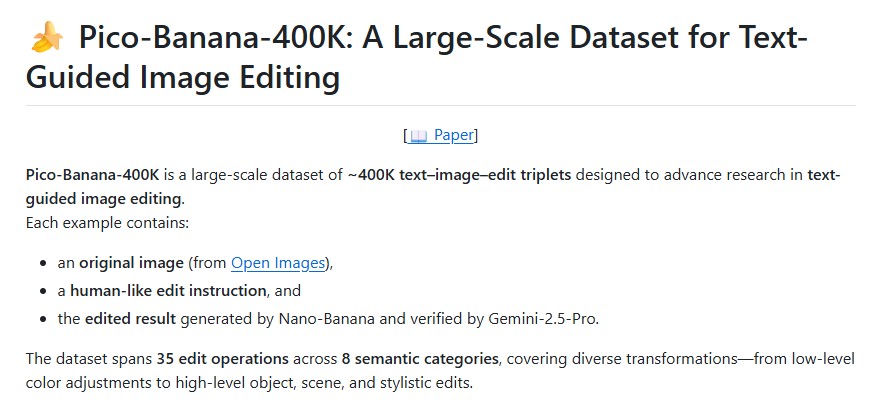Text-guided image editing has rapidly evolved with powerful multimodal models capable of transforming images using simple natural-language instructions. These models can change object colors, modify lighting, add accessories, adjust backgrounds or even convert real photographs into artistic styles. However, the progress of research has been limited by one crucial bottleneck: the lack of large-scale, high-quality, publicly shareable datasets built from real images for instruction-based image editing.

Pico-Banana-400K solves this gap. Introduced by Apple researchers, this dataset delivers nearly 400,000 curated image editing examples designed to accelerate innovation in multimodal AI, particularly in understanding and executing natural-language editing instructions. Built from real photographs and rigorously quality-filtered, Pico-Banana-400K is a valuable resource for building and benchmarking advanced editing models.
This article explores what Pico-Banana-400K is, how it was built, its unique advantages and why it represents a major step forward for AI-driven visual editing.
What Is Pico-Banana-400K?
Pico-Banana-400K is a large-scale dataset designed specifically for instruction-guided image editing research. It consists of approximately 400,000 image pairs generated from real photos paired with human-style and detailed edit instructions, delivering a rich training resource for editing models. According to the paper, the dataset contains 386,000 high-quality examples, including:
- 258K single-turn supervised editing pairs
- 56K preference examples comparing successful vs failed edits
- 72K multi-turn sequences for complex editing studies
These examples span diverse editing categories and real-world scenarios, making it one of the most comprehensive open datasets for image editing research.
Why This Dataset Matters
Earlier editing datasets often relied on synthetic images, manual annotations or small data scales limiting model generalization.
Pico-Banana-400K stands out by offering:
- Real photographs from OpenImages as the source material
- 35 categorized edit types across eight major editing groups
- Dual instruction styles: long technical prompts and short natural prompts
- Automated and manual quality filtering for realism and accuracy
- Multi-turn sequences for iterative and conversational editing tasks
This makes the dataset suitable for both foundational research and real-world model training.
Dataset Construction Pipeline
The creation of Pico-Banana-400K follows a multi-stage automated system combining state-of-the-art AI components:
Step 1: Data Source Selection
Researchers used diverse images from the OpenImages dataset, focusing on humans, scenes, objects, and text-containing images .
Step 2: Instruction Generation
For every image, two instruction formats were created:
- Long, detailed prompts written by Gemini-2.5-Flash
- Short, natural user-style instructions rewritten by Qwen using human examples
This dual approach bridges the gap between training-optimized prompts and real-world user phrasing.
Step 3: Automated Editing
Edits were generated using the high-performance Nano-Banana model, ensuring diversity across 35 edit categories. These include adding objects, changing seasons, performing artistic transformations, modifying text, altering human appearance and more .
Step 4: Quality Evaluation
Each edited image was evaluated by Gemini-2.5-Pro acting as a judge model. It scored edits on:
- Instruction compliance
- Seamlessness
- Content preservation
- Technical quality
Edits below a threshold were marked as failures and the model automatically retried up to three times.
Successful and failed edits were retained to support both supervised learning and preference-based training.
Multi-Turn Editing Support
Instead of isolating single edits, Pico-Banana-400K supports editing sequences where an image undergoes multiple transformations. For example, an image may be edited by:
- Adding a hat
- Changing its color
- Altering background lighting
- Applying a cartoon effect
This enables research in planning, reasoning, context retention, and instruction chaining crucial for interactive editing systems and AI agents.
Dataset Scale and Diversity
The dataset spans a wide range of edit styles and real-world contexts.
Key editing categories include:
- Pixel & photometric edits
- Object-level modifications
- Scene composition changes
- Artistic transformations
- Text replacement and editing
- Human-centric appearance changes
- Outpainting and scale edits
Each category contains thousands of curated examples ensuring balanced coverage.
Benchmarking Potential and Research Impact
Pico-Banana-400K is poised to support advancements in:
- Text-to-image editing models
- Multimodal instruction understanding
- Vision-language training
- Reward modeling and alignment
- Multi-step AI image editing workflows
The paper notes that failed edits serve as valuable preference learning data for alignment techniques such as Direct Preference Optimization (DPO) .
Conclusion
Pico-Banana-400K is a milestone dataset in the evolution of natural-language image editing. By combining real photo sources, dual instruction formats, automated quality evaluation and multi-turn editing capability, it delivers a comprehensive, scalable, and open resource for researchers and developers. This dataset will play a major role in training the next generation of editing-capable multimodal models, improving realism, instruction fidelity and human-like reasoning in image editing systems.
Follow us for cutting-edge updates in AI & explore the world of LLMs, deep learning, NLP and AI agents with us.
Related Reads
- PokeeResearch: Advancing Deep Research with AI and Web-Integrated Intelligence
- DeepAgent: A New Era of General AI Reasoning and Scalable Tool-Use Intelligence
- Generative AI for Beginners: A Complete Guide to Microsoft’s Free Course
- Open WebUI: The Most Powerful Self-Hosted AI Platform for Local and Private LLMs
- Dify: A Powerful #1 Production-Ready Platform for Building Advanced LLM Applications
